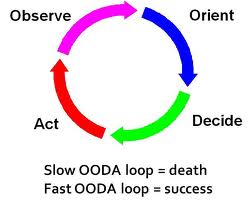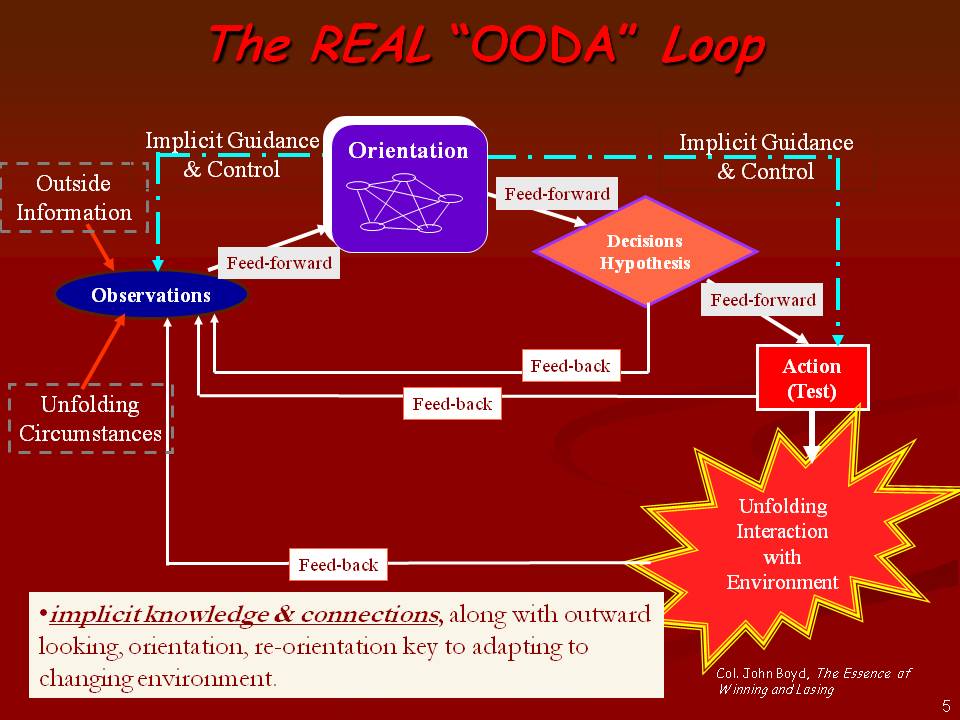Feb.17.2011
3:20 pm
by Ed Beakley
Boyd’s Way: More than Rapid – OODA Loops
Boundary Condition #4 (2)
From Searching for John Boyd:
… as PWH continues to research and provide discussion on decision making in severe crisis, Boyd and his “way” is the final of four boundary conditions. I intend to use the OODA notion of time cycles and competitive behavior as a “lens,” first for analysis of my intersection pieces (see previous 2011 Boundary Conditions posts) and then to explore how to build a Boyd “snowmobile” around the expanded idea from Dr. Richards of what kind of organization(s) can operate to recover and survive from a severe negative OODA (Observe-Orient-Decide-Act) start. I.e., how does a community “regain relative superiority” after the shovel in the back of the head?
As a general comment, the order and subjects of posts will not rigidly follow the order in which they were originally presented, and as in this case, having provided greater level of detail on Boundary Condition #1,Unconventional Crisis, in the last two posts, this post reflects what will probably be an ongoing approach : leveraging Boyd’s way of observation, analysis/synthesis as ingrained in orientation, and creation of actionable understandingas vehicles to bridge the ideas and stories that the boundary conditions are envisioned to convey. Specifically, before discussing aircraft carrier operations as reflective of a highly reliant organization in complex day-day operations, some key points from Boyd would seem beneficial.
In Science, Strategy and War; The Strategic Theory of John Boyd, Frans Osinga notes that “By some the OODA loop is perceived as the concise representation of (John Boyd’s) ideas. Thus the neat graphical depiction of the OODA loop has become the symbol of Boyd’s entire work.” He further argues “that the features that merit Boyd’s work the status of a general theory of strategy, do not lie solely in the rapid OODA loop idea but in several additional overarching insights concerning individual and organizational survival.
He continues that Boyd’s OODA loop concept, as well as his entire work are much more comprehensive, deeper and richer than the popular notion of “rapid OODA looping”that includes several additional overarching insights concerning individual and organizational survival.
Simply put, the OODA loop idea as advanced by Boyd says much more than “just” going through the decision cycle more rapidly than one’s opponent and subsequent critique on Boyd’s work should be based not on the simplified model but on the comprehensive picture painted by Boyd himself:
Of particular interest for us is the notion of novelty as put forward in the previous post on the impact of unconventional crisis. Boyd emphasized that “Indeed, change, novelty and mismatches are what keeps the evolutionary process going.” From Osinga:
Larger networks of organisms form ecosystems, together with various inanimate components linked to the animals, plants, and microorganisms through an intricate web of relations involving the exchange of matter and energy in continual cycles. Like individual organisms, ecosystems are self-organizing and self-regulating systems in which particular populations of organisms undergo periodic fluctuations… The flexibility of an ecosystem is a consequence of its multiple feedback loops, which tend to bring the system back into balance whenever there is a deviation from the norm, due to changing environmental conditions. Disturbances are ever-present because things in the environment change all the time.
It is the capacity to learn, to propagate successful traits and schemata, and to recombine in novel relationships that leads to the emergence of adaptation and evolution. Boyd would make this – the reveling in novelty, combined with the pervasive presence of uncertainty – key themes. If uncertainty is indeed pervasive, it is imperative for organizations to create the ability to operate comfortably in this condition, in fact, they need to embrace it and turn the capacity to their advantage by introducing uncertainty and novelty into the environment themselves.
Novelty is not only endemic property of our environment, it is also a fundamental characteristic of social systems and activities. Our own schemata and the interaction among schemata of people produce mismatches. The OODA loop is both the way we make sense of the world as well as the source of further uncertainty. Novelty is produced by a mental/physical feedback process of analysis and synthesis that permits us to interact with the world so that we can comprehend, cope with, and shape that world as well as be shaped by it.
Novelty enters strategy when Boyd concludes that winning and losing revolves around the capability to deal with uncertainty and to exploit this feature of novelty in the contest with opponents: Since survival and growth are directly connected with the uncertain, ever-changing, unpredictable world of winning and losing we will exploit this whirling (conceptual) spiral of orientation, mismatches, analysis/synthesis, reorientation, mismatches, analysis/synthesis.
The comprehensive OODA loop model can be applied to almost all levels as an explanatory tool. Boyd is persuasive in showing the relevance and the applicability of it at the individual, tactical, operational, strategic and, the grand strategic level. …Boyd’s work should not be regarded solely as a very valuable study of patterns in human conflict, although that is the nature of his work he started out with.
In Boyd’s later work he approached and explained those patterns from a more abstract point of view and drew parallels between evolution theory, complexity theory and military history. He moved beyond military history and warfare and shifted his focus to a number of similar, deep, underlying processes that unite various modes of survival and evolution. He examined the processes and factors that are at play when complex adaptive systems face challenges to their existence. He extended this to economies, societies and even to science and technology, showing how in these fields too self-correcting processes, the discovery of novelties, mismatches and anomalies, the continuous interplay of destruction and creation and the dialectic of analysis and synthesis that keep the process going. He then introduced the ‘theme for vitality and growth’… Osinga states that this strongly suggests A Discourse is a general theory of organizations in conflict, not only containing suggestions for winning battles, but also for maintaining organizational fitness, for organizational learning and change.
Osinga surmises that one could perhaps better describe Boyd’s work not as a general theory of war but as a general theory of the strategic behavior of complex adaptive systems in adversarial conditions. Importantly, his study of Boyd’s A Discourse on Winning and Losing shows that the larger theme of Boyd’s work, which is also embedded within the comprehensive OODA loop graphic, is multidimensional organizational adaptation in a dynamic non-linear environment.
The rapid OODA loop idea is a very important one, but in itself often misunderstood. Whereas rapid OODA loop is often equated with superior speed in decision making, Boyd employs the OODA loop model to show how organisms evolve and adapt. Boyd regards the OODA loop schematic in general as a model for organizational learning, or even more general, the way organisms adapt and thus evolve.
The value of Boyd’s work lies of course in the concepts he develops, but at least to an equal extent in the novel approach for thinking about strategy, making strategic theory and making strategy, and in introducing current scientific developments into strategic theory. In closing, Boyd’s words:
Novelty is produced continuously, if somewhat erratically or haphazardly. In order to thrive and grow in such a world we must match our thinking and doing, hence our orientation, with that emerging novelty. Yet, any orientation constrained by experiences before that novelty emerges introduce mismatches that confuse or disorient us. However, the analytical/synthetic process permits us to address these mismatches so that we can rematch thereby reorient our thinking and action with that novelty. Over and over this continuing whirl of re-orientation, mismatches, analysis/synthesis enables us to comprehend, cope with, and shape as well as be shaped by novelty that literally flows around and over us.
The next step: Carrier Aviation as prepresenting highly reliant operations and organization in the face of a day-day, both war and peace operational routine that while not qualifying as “unconventional” as we have framed it, is far from “routine.” And while the operations and environment may not lend themselves as a model, the PWH suggestion is there may be much to learn about decision making and action under very trying circumstance. Next: 100Years – Bad Night for Schoolboy & High reliance Organizations
————————————————————————————–Note: If the reader has followed Project White Horse 084640 to any degree since its beginnings in the Fall of 2006, he/she will have some knowledge of John Boyd, his work and the relevant books, plus the work of Boyd friend and only family authorized briefer of the Boyd work, Dr. Chet Richards. For those interested in greater level of detail, the Boyd Compendium on the Current Articles page is a quick link to the main body of work.
While all will be used as reference throughout the year, Frans Osinga’s Science Strategy and Warfare: The Strategy and Theory of John Boydwill be used extensively in these offerings. Osinga’s book focuses on providing a better understanding of the strategic thought developed by Boyd, and presents the material and analysis in the order in which Boyd evolved it with in depth look at the original sources. Osinga’s book has been described as the book Colonel Boyd himself would have written. Col Osinga has graciously provided a complete PDF version with permission to include in the White Horse Library.
Filed in 2011 Boundary Conditions,John Boyd,Unconventional Crisis | Comments Off on Boyd’s Way: More than Rapid – OODA Loops


